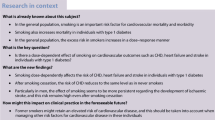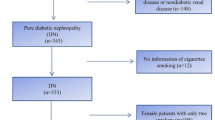Abstract
Aims
To evaluate the effect of cumulative smoking on the development of diabetic nephropathy.
Methods
Study included 3613 patients with type 1 diabetes, participating in the Finnish Diabetic Nephropathy Study. The 12-year cumulative risk of microalbuminuria, macroalbuminuria and end-stage renal disease (ESRD) was estimated for current, ex- and nonsmokers. Cox regression analyses, with multivariable adjustments for other risk factors for diabetic nephropathy, were used to evaluate the risk at different stages of diabetic nephropathy based on the cumulative amount of smoking in pack-years.
Results
The 12-year cumulative risk of microalbuminuria was 18.9 % (95 % CI 14.6–23.0, P < 0.0001) for current smokers and 15.1 % (10.3–19.6, P = 0.087) for ex-smokers, compared with 10.0 % (7.8–12.1) for nonsmokers. The corresponding risks of macroalbuminuria were 14.4 % (95 % CI 10.8–17.9, P < 0.0001), 6.1 % (3.5–8.6, P = 0.082) and 4.7 % (3.0–6.4), respectively. The 12-year cumulative risk of ESRD was 10.3 % (95 % CI 8.4–12.4, P < 0.0001) for current smokers and 10.0 % (7.9–12.3, P < 0.0001) for ex-smokers, compared with 5.6 % (4.6–6.7) for nonsmokers. In the current smokers, one pack-year increased the risk of macroalbuminuria with a HR of 1.025 (1.010–1.041) and the risk of ESRD with a HR of 1.014 (1.001–1.026) compared with nonsmokers, in the fully adjusted model. In the ex-smokers, the risk of macroalbuminuria and ESRD was no different from the risk in nonsmokers after multivariable adjustment.
Conclusions
Current smoking is a risk factor for the progression of diabetic nephropathy and the risk increases with the increasing dose of smoking. Ex-smokers seem to carry a similar risk of progression of diabetic nephropathy as nonsmokers.


Similar content being viewed by others
Abbreviations
- UAER:
-
Urinary albumin excretion rate
- eGFR:
-
Estimated glomerular filtration rate
- eGDR:
-
Estimated glucose disposal rate
- ESRD:
-
End-stage renal disease
- FinnDiane:
-
Finnish Diabetic Nephropathy Study
- IQR:
-
Interquartile range
References
Jha P, Ramasundarahettige C, Landsman V et al (2013) 21st-century hazards of smoking and benefits of cessation in the United States. N Engl J Med 368:341–350
Pirie K, Peto R, Reeves GK, Green J, Beral V, Million Women Study C (2013) The 21st century hazards of smoking and benefits of stopping: a prospective study of one million women in the UK. Lancet 381:133–141
Haroun MK, Jaar BG, Hoffman SC, Comstock GW, Klag MJ, Coresh J (2003) Risk factors for chronic kidney disease: a prospective study of 23,534 men and women in Washington County, Maryland. J Am Soc Nephrol 14:2934–2941
Hallan SI, Orth SR (2011) Smoking is a risk factor in the progression to kidney failure. Kidney Int 80:516–523
U.S. Renal Data System (2013) USRDS 2013 annual data report: atlas of chronic kidney disease and end-stage renal disease in the United States. National Institutes of Health, National Institute of Diabetes and Digestive and Kidney Diseases, Bethesda
Jacobsen P, Rossing K, Tarnow L et al (1999) Progression of diabetic nephropathy in normotensive type 1 diabetic patients. Kidney Int Suppl 71:S101–S105
Jenkins AJ, Lyons TJ, Zheng D et al (2003) Lipoproteins in the DCCT/EDIC cohort: associations with diabetic nephropathy. Kidney Int 64:817–828
Writing Team for the Diabetes Control and Complications Trial/Epidemiology of Diabetes Interventions and Complications Research Group (2003) Sustained effect of intensive treatment of type 1 diabetes mellitus on development and progression of diabetic nephropathy: the Epidemiology of Diabetes Interventions and Complications (EDIC) study. JAMA 290:2159–2167
Chase HP, Garg SK, Marshall G et al (1991) Cigarette smoking increases the risk of albuminuria among subjects with type I diabetes. JAMA 265:614–617
Muhlhauser I, Sawicki P, Berger M (1986) Cigarette-smoking as a risk factor for macroproteinuria and proliferative retinopathy in type 1 (insulin-dependent) diabetes. Diabetologia 29:500–502
Sawicki PT, Didjurgeit U, Muhlhauser I, Bender R, Heinemann L, Berger M (1994) Smoking is associated with progression of diabetic nephropathy. Diabetes Care 17:126–131
Couper JJ, Staples AJ, Cocciolone R, Nairn J, Badcock N, Henning P (1994) Relationship of smoking and albuminuria in children with insulin-dependent diabetes. Diabetes Med 11:666–669
Scott LJ, Warram JH, Hanna LS, Laffel LM, Ryan L, Krolewski AS (2001) A nonlinear effect of hyperglycemia and current cigarette smoking are major determinants of the onset of microalbuminuria in type 1 diabetes. Diabetes 50:2842–2849
Rossing P, Hougaard P, Parving HH (2002) Risk factors for development of incipient and overt diabetic nephropathy in type 1 diabetic patients: a 10-year prospective observational study. Diabetes Care 25:859–864
Hovind P, Rossing P, Tarnow L, Parving HH (2003) Smoking and progression of diabetic nephropathy in type 1 diabetes. Diabetes Care 26:911–916
Hovind P, Tarnow L, Rossing P et al (2004) Predictors for the development of microalbuminuria and macroalbuminuria in patients with type 1 diabetes: inception cohort study. BMJ 328:1105
Chaturvedi N, Stephenson JM, Fuller JH (1995) The relationship between smoking and microvascular complications in the EURODIAB IDDM Complications Study. Diabetes Care 18:785–792
Giorgino F, Laviola L, Cavallo Perin P, Solnica B, Fuller J, Chaturvedi N (2004) Factors associated with progression to macroalbuminuria in microalbuminuric type 1 diabetic patients: the EURODIAB Prospective Complications Study. Diabetologia 47:1020–1028
Gerber PA, Locher R, Schmid B, Spinas GA, Lehmann R (2013) Smoking is associated with impaired long-term glucose metabolism in patients with type 1 diabetes mellitus. Nutr Metab Cardiovasc Dis 23:102–108
Orth SR, Schroeder T, Ritz E, Ferrari P (2005) Effects of smoking on renal function in patients with type 1 and type 2 diabetes mellitus. Nephrol Dial Transplant 20:2414–2419
Thorn LM, Forsblom C, Fagerudd J et al (2005) Metabolic syndrome in type 1 diabetes: association with diabetic nephropathy and glycemic control (the FinnDiane study). Diabetes Care 28:2019–2024
Levey AS, Stevens LA, Schmid CH et al (2009) A new equation to estimate glomerular filtration rate. Ann Intern Med 150:604–612
Williams KV, Erbey JR, Becker D, Arslanian S, Orchard TJ (2000) Can clinical factors estimate insulin resistance in type 1 diabetes? Diabetes 49:626–632
Barua RS, Ambrose JA (2013) Mechanisms of coronary thrombosis in cigarette smoke exposure. Arterioscler Thromb Vasc Biol 33:1460–1467
Nilsson PM, Gudbjornsdottir S, Eliasson B, Cederholm J, Steering Committee of the Swedish National Diabetes Register (2004) Smoking is associated with increased HbA1c values and microalbuminuria in patients with diabetes–data from the National Diabetes Register in Sweden. Diabetes Metab 30:261–268
Facchini FS, Hollenbeck CB, Jeppesen J, Chen YD, Reaven GM (1992) Insulin resistance and cigarette smoking. Lancet 339:1128–1130
Axelsson T, Jansson PA, Smith U, Eliasson B (2001) Nicotine infusion acutely impairs insulin sensitivity in type 2 diabetic patients but not in healthy subjects. J Intern Med 249:539–544
Bergman BC, Perreault L, Hunerdosse DM, Koehler MC, Samek AM, Eckel RH (2009) Intramuscular lipid metabolism in the insulin resistance of smoking. Diabetes 58:2220–2227
Bergman BC, Perreault L, Hunerdosse D et al (2012) Novel and reversible mechanisms of smoking-induced insulin resistance in humans. Diabetes 61:3156–3166
Seet RC, Loke WM, Khoo CM et al (2012) Acute effects of cigarette smoking on insulin resistance and arterial stiffness in young adults. Atherosclerosis 224:195–200
Tolonen N, Forsblom C, Thorn L et al (2009) Lipid abnormalities predict progression of renal disease in patients with type 1 diabetes. Diabetologia 52:2522–2530
Helakorpi S, Holstila A, Virtanen S, Uutela A (2011) Health Behaviour and Health among the Finnish Adult Population, Spring 2011. National Institute for Health and Welfare (THL). http://urn.fi/URN:ISBN:978-952-245-566-6. Accessed November 2012
Acknowledgments
The authors would like to acknowledge all physicians and nurses at each FinnDiane Center participating in patient recruitment and characterization (see online supplement).
Funding
This research was supported by grants from the Folkhälsan Research Foundation, Academy of Finland (134379), Wilhelm and Else Stockmann Foundation, Diabetes Research Foundation, Liv och Hälsa Foundation, Finska Läkaresällskapet, NovoNordisk Foundation, Signe and Ane Gyllenberg Foundation and Päivikki and Sakari Sohlberg Foundation. The funding sources were not involved in the design or conduct of the study.
Author contribution
MF designed the study, carried out statistical analyses and wrote the manuscript. VH contributed to the design of the study, statistical analyses and aspects of the manuscript. CF contributed to the design of the study and critically revised the manuscript. LT, JW, NT and RL contributed to the collection of the data and critically revised the manuscript. P-HG contributed to the study design and edited and critically revised the manuscript. P-HG is the guarantor of this work, as such, had full access to all the data in the study and takes responsibility for the integrity of the data and the accuracy of the data analysis. All authors approved the final version of the manuscript for publication.
Author information
Authors and Affiliations
Corresponding author
Ethics declarations
Conflict of interest
P.-H. G. has received lecture honorariums from Astra Zeneca, Boehringer Ingelheim, Eli Lilly, Genzyme, Medscape, MSD, Novartis, Novo Nordisk and Sanofi. P.-H. G. is an advisory board member of Abbott, AbbVie, Boehringer Ingelheim, Cebix, Eli Lilly, Janssen, Medscape and Novartis. P.-H. G. has received investigator-initiated study grants from Eli Lilly and Roche. No other potential conflicts of interest relevant to this article were reported.
Ethical standard
The study was conducted in accordance with the Declaration of Helsinki and accepted by the Helsinki University Hospital Research Ethics Committee.
Human and animal rights
All procedures followed were in accordance with the ethical standards of the responsible committee on human experimentation (institutional and national) and with the Helsinki Declaration of 1975, as revised in 2008.
Informed consent
Informed consent was obtained from all patients for being included in the study.
Additional information
Managed by Massimo Federici.
On behalf of the FinnDiane Study Group.
Electronic supplementary material
Below is the link to the electronic supplementary material.
Rights and permissions
About this article
Cite this article
Feodoroff, M., Harjutsalo, V., Forsblom, C. et al. Smoking and progression of diabetic nephropathy in patients with type 1 diabetes. Acta Diabetol 53, 525–533 (2016). https://doi.org/10.1007/s00592-015-0822-0
Received:
Accepted:
Published:
Issue Date:
DOI: https://doi.org/10.1007/s00592-015-0822-0




